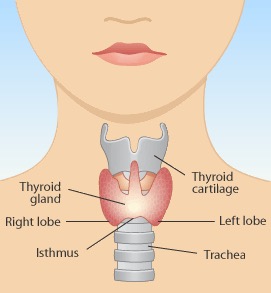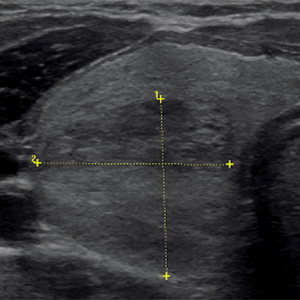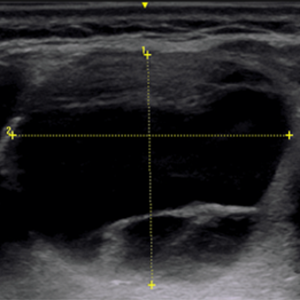The Thyroid Gland
What is the Thyroid Gland?
The thyroid gland sits in low in the neck in the midline. It is a butterfly shaped gland composed of three parts – a right lobe, left lobe and central joining piece called the isthmus. The thyroid gland produces thyroid hormone which is responsible for controlling our metabolic rate.
What can go wrong with the Thyroid Gland?
There are two basic problems that can affect the thyroid gland. The first affects the hormone production of the gland. In this case, the gland either produces too much thyroid hormone (termed hyperthyroidism) or too little hormone (termed hypothyroidism). In hyperthyroidism, the excess thyroid hormone causes your body to work too hard, resulting in symptoms such as anxiety, heart palpitations, weight loss, heat intolerance, and insomnia. In hypothyroidism, the paucity of thyroid hormone prevents your body from meeting its energy demands, resulting in symptoms such as depression, weight gain, fatigue, cold intolerance, hair loss and leg swelling. Hormonal disturbances of the thyroid are usually managed by an endocrinologist.
The second problem that can affect the thyroid is the development of thyroid nodules or growths within the lobes or isthmus of the thyroid gland.

What are thyroid nodules?
Thyroid nodules are lumps that grow within the thyroid gland. Thyroid nodules are very common. It is estimated that over 50% of the population aged over 50 years has thyroid nodules. Most thyroid nodules are not cancerous and do not cause symptoms. Under 5% of nodules are cancerous. Of the >95% of thyroid nodules that are not cancerous, some can grow to a size that requires a biopsy to ensure there is no risk of cancer. Some can grow large enough to cause symptoms such as swallowing difficulties, hoarse voice, neck discomfort, shortness of breath and visible evidence of a neck mass. These nodules may require treatment with surgery or ablation.
Ultrasound Image of a thyroid nodule in the right lobe of the thyroid. The grey color indicates a solid lesion

What are thyroid nodules?
Thyroid nodules are lumps that grow within the thyroid gland. Thyroid nodules are very common. It is estimated that over 50% of the population aged over 50 years has thyroid nodules. Most thyroid nodules are not cancerous and do not cause symptoms. Under 5% of nodules are cancerous. Of the >95% of thyroid nodules that are not cancerous, some can grow to a size that requires a biopsy to ensure there is no risk of cancer. Some can grow large enough to cause symptoms such as swallowing difficulties, hoarse voice, neck discomfort, shortness of breath and visible evidence of a neck mass. These nodules may require treatment with surgery or ablation.
Ultrasound image of a thyroid cyst in the right thyroid lobe. The black colour indicates fluid.

Do thyroid nodules grow with time?
Thyroid nodules generally grow slowly over years. Growth is considered ‘normal’ if it is less than 1-2 mm per year. Some nodules can grow more rapidly however, and these nodules require close observation, possibly repeat biopsy and occasionally surgical or non-surgical intervention. Nodules rarely shrink. Thyroid cysts can fluctuate in size.